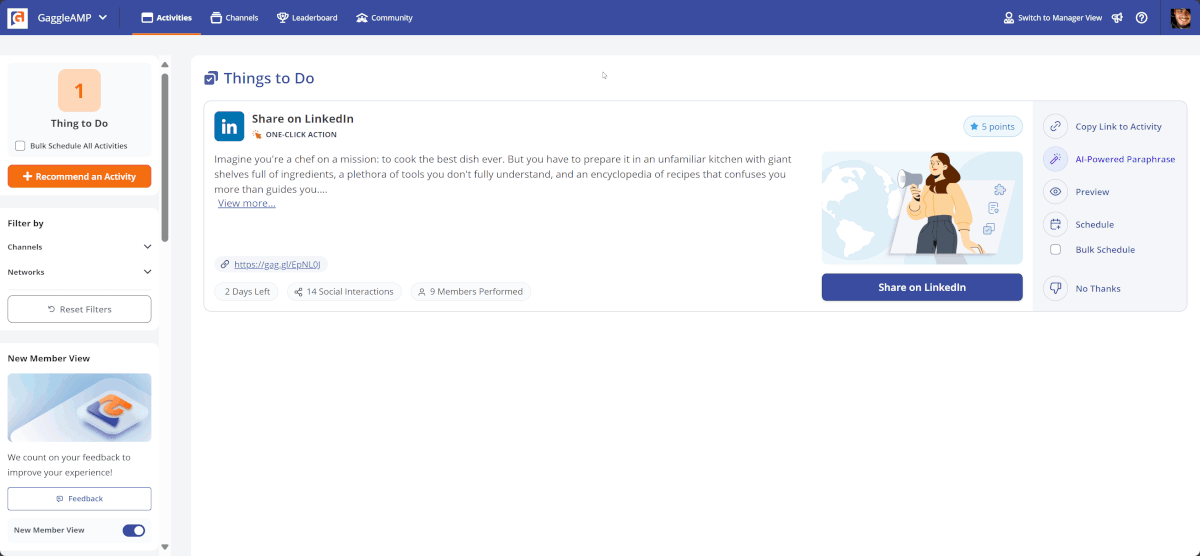Content Marketing vs Social Media: Why B2B Teams Need Both
Content marketing gets you dates. Social media gets you noticed. Just saying.
B2B marketers are navigating one of the noisiest landscapes in history. Everyone is producing content. Everyone is trying to go viral. And leadership? They're demanding proof—proof of ROI, proof of engagement, and proof that marketing isn’t just making noise but actually moving the needle.
Consider this: according to a study by Demand Gen Report, a key challenge for nearly 60% of B2B marketers is generating high-quality leads. That’s why the debate between content marketing and social media marketing is more relevant than ever.
Too often, teams pit one against the other, pouring resources into long-form content while neglecting distribution, or chasing social trends without foundational content to support them.
Let's explore which strategy, or a smart combination, is right for your B2B goals. First, let's define each.
What Is Content Marketing and Why It’s Critical for Long-Term Success
Content marketing for B2B is about creating and consistently sharing valuable, relevant information for a specific audience. Think blogs, whitepapers, webinars, and video series—all designed to nurture trust and guide prospects through the funnel.
When done consistently, this type of content doesn’t just educate—it performs. In fact, content marketing generates about three times more leads than outbound marketing, according to the Content Marketing Institute. That lead-generating power is exactly why it’s a core strategy for nurturing trust and guiding prospects through the funnel.
The goal? To drive profitable customer actions.
The Core Objectives of Content Marketing
A solid content marketing strategy supports:
-
Build authority and trust.
-
Generate qualified leads for complex solutions.
-
Nurture prospects through the sales cycle.
-
Improve SEO and organic visibility.
-
Support customer retention and advocacy.
-
Become a thought leader to your buyers.
-
Create brand awareness.
Content marketing builds trust and expertise with high-value content that directly addresses your audience's needs, helping you attract new customers and build lasting relationships.
When done right, content marketing turns your brand into a resource rather than just a vendor.
What Is Social Media Marketing and Its Unique Power in the B2B Funnel
Social media marketing is the megaphone. It brings your message into the real-time stream of your audience's daily lives. But it's not just about visibility—it's about valuable interactions, community building, and sharing relevant industry news.
Multiple reports indicate that over 80% of B2B social media leads come from LinkedIn. This is also evidenced in a report by the Content Marketing Institute where they indicate that 85% of B2B marketers say LinkedIn delivers the best value among social media platforms.
Social media marketing for B2B uses platforms such as LinkedIn or Twitter/X to connect with audiences and achieve specific marketing goals:
-
Employee advocacy: Team members amplifying branded content.
-
Social selling: Engaging prospects through thought leadership.
-
Brand humanization: Showing the people and personality behind the logo.
Key Objectives of Social Media Marketing
-
Increase brand visibility.
-
Enable direct engagement.
-
Share industry news and company updates.
-
Drive traffic to valuable content.

Educational posts like this one from SEMrush help brands position themselves as industry experts on social platforms.



Types of Social Media Marketing
-
Organic: Building relationships and sharing valuable content without direct payment.
-
Paid: Using platform ads to target specific professional profiles (e.g., LinkedIn Ads).
-
Social Listening: Monitoring conversations for trends, competitor info, and customer sentiment.
-
Social Selling: Directly engaging and nurturing potential leads on social platforms.
Social media marketing not only amplifies real-time visibility and employee-driven brand momentum, but it also serves as the pathway to connect, share, and engage with your target audiences.
What are the Key Differences Between Social Media Marketing and Content Marketing?
To understand why social media marketing works differently than content marketing, it’s helpful to compare their core functions side by side:
| Feature | Content Marketing | Social Media Marketing |
|---|---|---|
| Primary Goals | Trust, education, SEO | Visibility, engagement, and virality |
| Content Formats | Blogs, whitepapers, videos | Posts, memes, polls, reels |
| Time-to-ROI | Long-term (3–6+ months) | Short-term (hours to weeks) |
| KPIs | Time on page, backlinks, downloads | Shares, comments, reach |
| Platform Longevity | High (evergreen) | Low (ephemeral) |
| Automation Potential | High (CMS, email) | Medium (schedulers, advocacy tools) |
| Distribution Channel | Owned media (website, email) | Native social platforms (LinkedIn, Twitter/X) |
Understanding the core differences helps you use each effectively.
-
Focus and Objectives: Content marketing aims to attract, engage, and retain audiences with valuable content for long-term lead generation and thought leadership. In contrast, social media marketing focuses on engaging audiences on platforms like LinkedIn for brand visibility and traffic, often targeting immediate engagement metrics.
-
Content Nature and Format: Content marketing leans on longer, in-depth assets—think blog posts, ebooks, and whitepapers—hosted on owned platforms. Social media marketing thrives on concise, visual, and interactive content formats tailored to specific platform behaviors.
-
Time Horizon and Results: Content marketing is a long game—it builds SEO value, domain authority, and nurturing pathways over time. Social media offers immediacy. It delivers quick wins in reach and engagement.
-
Engagement and Interaction: With content marketing, interaction often comes through comments on blogs, form submissions, or email replies. On social media, engagement is more spontaneous and community-driven—likes, shares, comments, and DMs happen in real time.
-
Platform Longevity: Content pieces like evergreen blog posts or pillar pages can remain discoverable and useful for months or even years. Social media posts, however, have a short lifespan—often measured in hours or days.
-
Automation Potential: Content marketing benefits from automation through tools like CMS systems, email platforms, and content scheduling. Social media marketing can be partially automated using scheduling tools and employee advocacy platforms like GaggleAMP.
-
Distribution Channels: Content marketing is primarily hosted on owned channels like websites and email, then distributed further via social. Social media marketing lives natively on platforms like LinkedIn and Twitter/X, where speed and frequency are critical.
How Content and Social Work Together to Maximize B2B Marketing Impact
Here’s the truth: content marketing and social media marketing aren’t rivals. They’re partners.
Think of your marketing strategy like a flywheel:
-
Create content that serves as a cornerstone asset (e.g., a research report).
-
Atomize it into microcontent (e.g., infographics, quotes, carousels).
-
Distribute via social and employee advocacy tools.
-
Track engagement, feedback, and conversions.
-
Refine future content based on what works.
Beyond that flywheel, content and social intersect in several high-impact areas specific to B2B:
-
Establishing Thought Leadership and Positioning Experts: Publish expert-led blog content and amplify it through social media channels. Participate in timely industry conversations to deepen credibility.

-
Driving Product Launch Visibility: Use in-depth blogs and videos to explain new product features, then share teasers, visuals, and launch updates across social platforms for real-time awareness.
-
Event Marketing and Amplification: Pair blog recaps, landing pages, or speaker interviews with social campaigns that build buzz before the event and offer live updates during.
-
Showcasing Customer Wins and Testimonials: Develop case studies that live on your site, then extract compelling quotes or insights to share via social for added trust and visibility.

-
Becoming a Source for Industry Trends and News: Use your blog to dive deep into market shifts and trend analysis, while social helps you quickly distribute commentary and curated news your audience cares about.
Grasping the distinction between digital marketing and social media marketing in a B2B context can help sharpen your strategy. While digital marketing is the broader ecosystem, media and content marketing are the twin engines driving narrative and engagement at scale.
When these two strategies work in sync, they generate compounding returns—greater reach, higher engagement, and smarter campaign optimization.
Where Each Strategy Fits in the Funnel
Understanding where each strategy shines in the funnel is critical for planning:
-
Top of Funnel (ToFU): Social media marketing wins here. It's where prospects first encounter your brand. Think awareness, impressions, clicks.
-
Middle of Funnel (MoFU): Both content and social can shine, especially when you're nurturing interest.
-
Bottom of Funnel (BoFU): Content marketing becomes the star, offering deep-dive resources that help justify purchase decisions and convert potential customers.

Example:
-
You promote a blog post on LinkedIn (ToFU).
-
The blog links to a gated guide (MoFU).
-
The guide includes a CTA to request a demo (BoFU).
Matching the strategy to funnel stages ensures efficient resource allocation and message relevance. A well-structured social media marketing plan helps ensure you’re using the right platform, message, and metric at every stage.
Choosing the Right Strategy Based on Your Goals
There’s no one-size-fits-all; clarity comes from aligning strategy to outcomes. Use this matrix to guide your decision:
| Factor | Lean Toward Content Marketing | Lean Toward Social Media Marketing |
|---|---|---|
| Budget | Lower ad spend, higher time investment | Paid social boosts reach quickly |
| Team Bandwidth | Strong writers and strategists | Agile creatives and community managers |
| Content Maturity | Mature library needing amplification | Little existing content to build from |
| Quick Wins Needed | Not ideal | Very effective |
| Stakeholder Pressure | Long-term trust preferred | Need fast visibility or proof |
B2B marketers today often face pressure to justify social ROI fast while juggling content production. The strategy you choose can either anchor your long-term vision or fuel a specific marketing campaign that requires rapid visibility. The right tool can alleviate that tension.
How GaggleAMP Amplifies Both Strategies for B2B Teams
Here’s where GaggleAMP bridges the divide:
-
Simplifies distribution: Share content via Slack or Teams with one click.
-
Boosts participation: Gamified engagement gets sales and execs involved.
-
Proves ROI: Detailed reporting shows clicks, reach, and conversions.

For marketers who struggle to get Sales to post or to prove ROI, GaggleAMP is a game-changer. It removes friction, motivates employees, and makes the results trackable.
GaggleAMP bridges the gap between content creation and social activation at scale.
Stop Guessing. Start Integrating. Scale with the Right Mix
The real question isn't which strategy is better, but rather how can they work together better? A well-defined social media marketing strategy is key to making that integration meaningful and measurable. B2B brands thrive when they move from siloed efforts to integrated, measurable strategies.
When content and social media efforts are aligned, and social expands content visibility, growth becomes exponential. And with platforms like GaggleAMP, scaling that synergy becomes not only possible but practical.
Ready to align your social and content marketing for greater reach and ROI? Try GaggleAMP for Free.













